| View previous topic :: View next topic |
| Author |
Message |
Elise

Joined: 22 Dec 2009
Posts: 243
Location: New York State



|
 Posted: Sep 29, 2010 11:53 Post subject: Inclusions of spiral or helical growth and screw dislocations - (0) Posted: Sep 29, 2010 11:53 Post subject: Inclusions of spiral or helical growth and screw dislocations - (0) |
|
|
Hi,
Duncan wrote me yesterday regarding these types of inclusions - I had mentioned it somewhere on FMF after the Rochester Symposium, but I don't think it ever caught on as a topic so I thought I would try again. I have always found them very intriguing and they were a great source of debate/talk at the Symposium last Spring. I went back to John and Duncan's brief discussion of it from May 2009 in which John posted a beautiful photomicrograph taken by John Koivula of JSW's beryl https://www.mineral-forum.com/message-board/viewtopic.php?p=5505&highlight=#5505 Maybe others could post any pictures they have or John might repost his here.
Pasting in part of what I wrote to Duncan yesterday (this is my lunch break and I don't have time to re-type): "This was hot controversy at the Rochester Mineral Symposium this Spring. I met someone who is involved in investigating the cause (John Rakovan); I'll try to get that information to you when it is published or if I hear more about it.
We (Olaf, Jeff and others) discussed it during breaks when one attendee passed around a hand-sized beautiful kunzite spodumene with a helix running its length which Jeff had also imaged. Many people, including Bill, are of the opinion that it is a type of screw dislocation, but Olaf and others argue that screw dislocations are only sub-microscopic. A model which Bill constructed back when he was teaching mineralogy sits on my desk in his lab and I actually contemplate it whenever I sit there - a hexigon of red marbles inbedded in clay and rising in a helical fashion, really quite pretty.
I tried to get a discussion about this going on FMF, but it didn't catch on. My young friend who brought back all the specimens from Pakistan this past year (I posted some images on FMFof his spinels) had many aquamarines with these helix inclusions, some with several in one crystal, all parallel to the C axis and most starting some distance up from the bottom of the crystal and which break the surface of the pinacoid.
Back to the kunzite -- this relatively large helix broke the crystal face surface at each turn and with my loop I could peer into it at each rotation; the formation was hollow throughout (postscript: in hindsight - I don't know if these were actually more like JSW's specimen where it is not actually a helix but "twisted wings" coming off of a helix which broke the surface - even so, why do they break the surface? is it that in this bladelike monoclinic crystal there just isn't room in the short axis direction?)
There are many published photos of these - There is a beautiful image published in Lithographie No 7 Beryl: a 9 cm aquarmarine beryl from Pakistan with a helix running its length -- and others published elsewhere by inclusionist John Koivula - he has some neat images of these in beryl and topaz in the Photolexicon (CGA 2003, 24, 1 ) underwhich he notes that "What causes a helix to develop in a beryl or topaz crystal during its growth is not completely understood. Such inclusions are always oriented parallel to the c-axis, and appear to be associated with strain zones that run the entire length of the inclusion. Whether the helix caused the strain, or strain caused the helix to develop is still under investigation. Perhaps helical inclusions are the result of strain along linear dislocations in the structure." I interpreted that as meaning a screw dislocation, but maybe that's wrong. In the later F05 issue of G&G, John describes such a feature in a 53.4 mm beryl (pictured) as being "a visual form of growth disturbance propagated through the host crystal along a screw dislocation that develops from a source such as a small solid inclusion or a structural defect, often at or near the base of a crystal during the earliest stages of growth." By this could he mean that the helix itself is not the screw dislocation, but an artifact resulting along it? They are fun to study for sure."
I think Bill's answer to me when I returned from Rochester to tell him about it was more of a question back to me to ponder - as in why couldn't it be a screw dislocation? Today when I told him about what I had written here and showed him the images in the above journals, he qualified that a screw dislocation would be at the unit level and that at the pinacoid we would see a hillock with the SEM. These helical inclusions here are on a macro-scale and he was fascinated that I found them to be hollow and breaking the faces. He is very interested in what people will say and what John Rakovan might be finding.
John, I wondered if you or anyone else had found out John Rakovan's thoughts on this or if he has/will publish anything on it since the Rochester Symposium. I have only personally seen them in beryls and spodumene; other than these and topaz, what other minerals have they been found in?
By the way, my friend's little store was robbed of over $20 K in specimens over Labor Day weekend, many of them from his Pakistan/China trip last Winter https://www.mineral-forum.com/message-board/viewtopic.php?p=10830&highlight=#10830 I don't know if the beryls with the helices were among those lost, but I will see what he has left and try to perk up his spirits with any insights FMF has on these special inclusions. He had some at the Springfield show I believe; perhaps he had a good weekend and sold them before the break-in.
Best wishes,
Elise
(ok, that did take me longer than lunch to write despite cut and paste effort)
_________________
Elise Skalwold |
|
| Back to top |
|
 |
Duncan Miller

Joined: 25 Apr 2009
Posts: 138
Location: South Africa



|
 Posted: Sep 30, 2010 05:13 Post subject: Re: Inclusions of spiral or helical growth and screw dislocations - (0) Posted: Sep 30, 2010 05:13 Post subject: Re: Inclusions of spiral or helical growth and screw dislocations - (0) |
|
|
There are some very good photographs of these helical growth features, in beryl, topaz and spodumene on the GemologyOnline Forum at:
https://gemologyonline.com/Forum/phpBB2/viewtopic.php?f=8&t=12302&sid=edfdd38d23837cfc7f4c3dbe15bc83f0
(link normalized by FMF)
You don't have to be a member to view them. There is also some speculation about their origin. I like the idea that a screw dislocation establishes a stress field, which is relieved by the radial propagation of cracks. It will be interesting to hear what the mineralogy experts on this forum think.
Duncan Miller
|
|
| Back to top |
|
 |
Elise

Joined: 22 Dec 2009
Posts: 243
Location: New York State



|
 Posted: Oct 02, 2010 23:29 Post subject: Re: Inclusions of spiral or helical growth and screw dislocations - (0) Posted: Oct 02, 2010 23:29 Post subject: Re: Inclusions of spiral or helical growth and screw dislocations - (0) |
|
|
Jeff sent me a photo to share with FMF of the kunzite crystal which we examined at the Rochester Symposium; he is also looking forward to hearing what theories people have. It is a spectacular formation and a beautiful portrait of this specimen.
Cheers!
Elise
| Description: |
Kunzite spodumene with helical inclusion running parallel to c axis. Crystal is resting on its side; long dimension approx. 11.4 cm
Photo courtesy of Jeff Scovil |
|
| Viewed: |
107252 Time(s) |
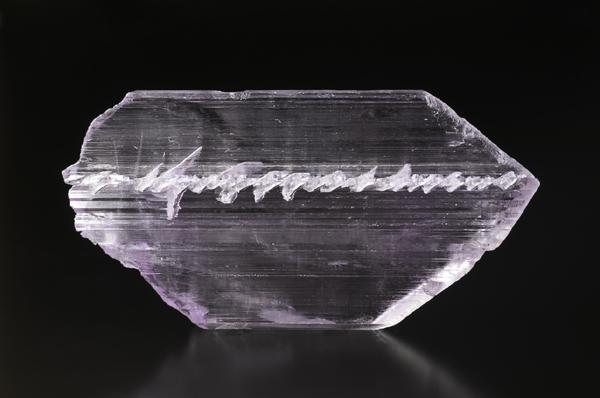
|
_________________
Elise Skalwold |
|
| Back to top |
|
 |
mmauthner
Joined: 30 May 2007
Posts: 113
Location: Graz


|
 Posted: Oct 04, 2010 18:23 Post subject: Re: Inclusions of spiral or helical growth and screw dislocations - (0) Posted: Oct 04, 2010 18:23 Post subject: Re: Inclusions of spiral or helical growth and screw dislocations - (0) |
|
|
Elise,
We have seen the same type of helical etched channels in spodumene crystals from the recent Big Kahuna pocket at the Oceanview mine.
Attached is a photo of the largest crystal we found. The channel is visible on the right side. Unfortunately I was in a bit of a hurry and did not think to take a close-up photo of the channel "inclusions".
Cheers,
Mark
| Description: |
| Spodumene (kunzite); 21 cm tall. Big Kahuna pocket, Oceanview Mine, Pala District, San Diego County, California, USA. Oceanview Mines, LLC specimen; Mark Mauthner photo. |
|
| Viewed: |
107101 Time(s) |
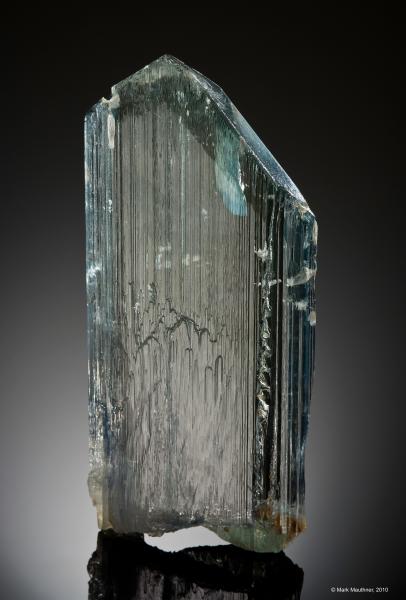
|
|
|
| Back to top |
|
 |
Pete Richards
Site Admin
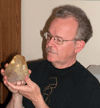
Joined: 29 Dec 2008
Posts: 841
Location: Northeast Ohio



|
 Posted: Oct 04, 2010 18:43 Post subject: Re: Inclusions of spiral or helical growth and screw dislocations - (0) Posted: Oct 04, 2010 18:43 Post subject: Re: Inclusions of spiral or helical growth and screw dislocations - (0) |
|
|
These spiral inclusions are most amazing and puzzling! Appealing to spiral dislocations is tempting, but there are several problems.
Some research indicate that spiral dislocations are found in the millions per square centimeter - if so, why is there any crystal left?!!!! Why are spiral tunnels so rare? This research, however, has focused on metals and alloys, and perhaps the defect density there is orders of magnitudes greater than that for free-grown natural mineral crystals.
Typical spiral dislocations have offsets of one unit cell - generously about 10 angstroms or 1 millionth of a millimeter. The unit cell dimension should determine the pitch of the screw. There are mechanisms proposed for stacking up steps caused by spiral defects to create larger step sizes, but to get to a visible step size as in these spirals would require stacking up some 2,000,000 steps. This seems implausible - how do you do it?
I have not read this literature for a decade or so, so there may be more recent thinking. If someone is familiar with it, I'd welcome comments.
And if my comments are accurate, they leave me saying that I don't understand why these things happen! So they are wonder-full.
Pete Richards
_________________
Collecting and studying crystals with interesting habits, twinning, and epitaxy |
|
| Back to top |
|
 |
Duncan Miller

Joined: 25 Apr 2009
Posts: 138
Location: South Africa



|
 Posted: Oct 05, 2010 02:17 Post subject: Re: Inclusions of spiral or helical growth and screw dislocations - (0) Posted: Oct 05, 2010 02:17 Post subject: Re: Inclusions of spiral or helical growth and screw dislocations - (0) |
|
|
Before and after pictures of my beryl specimen. Two faces were crudely polished before I acquired it, so I cut the stone to show the helix more clearly. In fact, there are several helices, and a sawn off piece produced a smaller stone with another helical inclusion. The cut stone is 40 mm long, so you can get some idea of the pitch of the helix. It is a helical fracture (shaped like a "spiral" staircase) with paddle-shaped 'wing' fractures emanating at regular intervals on two sides from the helix. I analysed the outcrop of the main helix on a piece cut off the end of the crystal, using X-ray fluorescence spectroscopy in the SEM, and detected no foreign mineral that could have acted as a core. Perhaps someone more competent than I needs to do finite element models of the stress fields in beryl, spodumene and topaz required to produce these cracks. I guess the different crystallographies would account for the different appearances of these helical features in the different minerals, i.e. the variable pitch and size of the cracks, although they don't seem to be determined by cleavage.
Pete is quite right, that screw dislocations are at the unit level, and it is hard to think of how they could give rise to macroscopically observable helices like these, but it is tempting to invoke them because how else can one initiate a regular helix in single crystals of diverse crystallography? Has anyone found one in quartz yet, and if not, why not?
Duncan
| Description: |
|
| Viewed: |
107018 Time(s) |
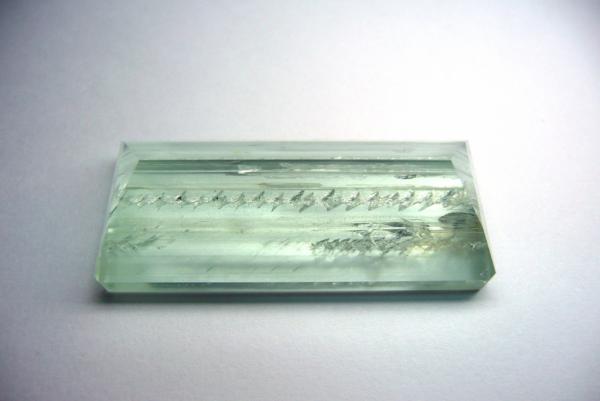
|
| Description: |
|
| Viewed: |
106964 Time(s) |
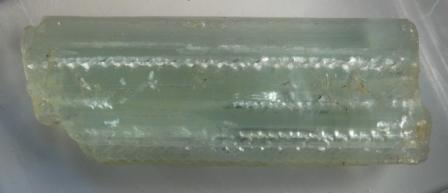
|
|
|
| Back to top |
|
 |
John S. White
Site Admin

Joined: 04 Sep 2006
Posts: 1298
Location: Stewartstown, Pennsylvania, USA



|
 Posted: Apr 01, 2011 04:35 Post subject: Re: Inclusions of spiral or helical growth and screw dislocations - (0) Posted: Apr 01, 2011 04:35 Post subject: Re: Inclusions of spiral or helical growth and screw dislocations - (0) |
|
|
Elise requested that I post this John Koivula photo of a beryl in my collection that was cut into a gem measuring some 4 cm in length. The portion in the photo is about 1 cm across. The beryl is from Brazil, presumably Minas Gerais, but the specific locality is unknown.
| Description: |
|
| Viewed: |
106018 Time(s) |
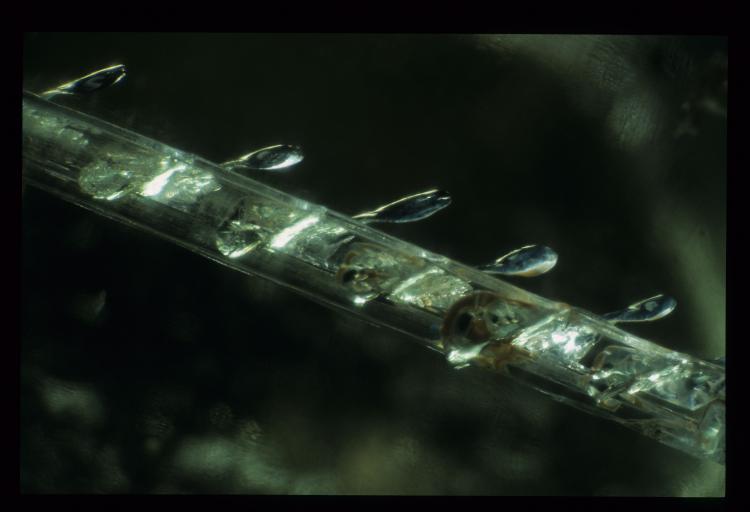
|
_________________
John S. White
aka Rondinaire |
|
| Back to top |
|
 |
John S. White
Site Admin

Joined: 04 Sep 2006
Posts: 1298
Location: Stewartstown, Pennsylvania, USA



|
 Posted: Apr 01, 2011 05:16 Post subject: Re: Inclusions of spiral or helical growth and screw dislocations - (0) Posted: Apr 01, 2011 05:16 Post subject: Re: Inclusions of spiral or helical growth and screw dislocations - (0) |
|
|
The entire cut stone. Jeff Scovil photo. The stone is actually more green in color than it appears here.
| Description: |
|
| Viewed: |
106017 Time(s) |
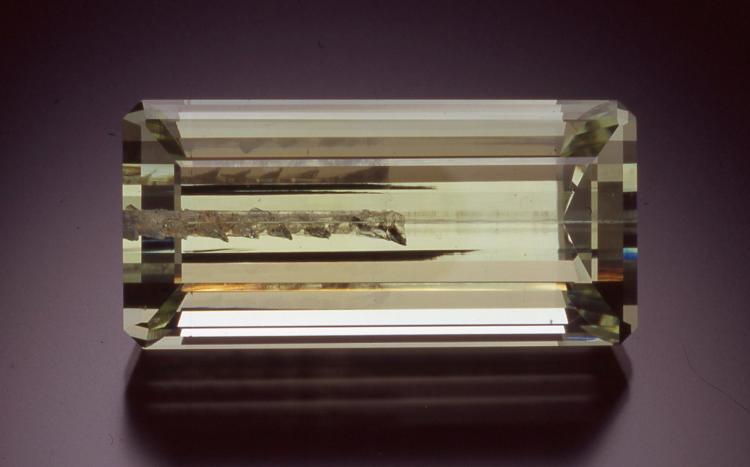
|
_________________
John S. White
aka Rondinaire |
|
| Back to top |
|
 |
Elise

Joined: 22 Dec 2009
Posts: 243
Location: New York State



|
 Posted: Apr 23, 2011 12:45 Post subject: Re: Inclusions of spiral or helical growth and screw dislocations - (0) Posted: Apr 23, 2011 12:45 Post subject: Re: Inclusions of spiral or helical growth and screw dislocations - (0) |
|
|
Hi,
I am hoping we might reignite this thread after hearing John Rakovan's presentation at the Rochester Symposium last weekend. Below is the model I mentioned at the start of this thread; I am still contemplating it after a year. While the marbles are tactile, not to mention beautiful in the sun, John's 3-D diagrams and explanation of screw dislocations were much more enlightening; though as he concluded, mysteries remain as to the genesis of the helical inclusions. I am still mulling it over...I wish John had a rewind button so I could hear it once again, this time more slowly! Maybe someone here can give a synopsis. The Symposium was a wonderful event once again and it was so nice to see everyone there (it was a great way to spend my 53rd; thank you all for singing me happy birthday - my face may have been the color of these marbles, but that was just because it made me feel so good)!
Best wishes,
Elise
| Description: |
|
| Viewed: |
105752 Time(s) |
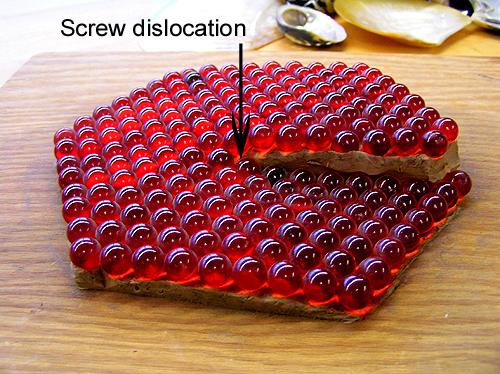
|
_________________
Elise Skalwold |
|
| Back to top |
|
 |
michael-thorn
Joined: 18 Apr 2011
Posts: 8
Location: Santa Rosa, California


|
 Posted: Apr 25, 2011 00:22 Post subject: Re: Inclusions of spiral or helical growth and screw dislocations - (0) Posted: Apr 25, 2011 00:22 Post subject: Re: Inclusions of spiral or helical growth and screw dislocations - (0) |
|
|
In these cases, is not the center of the crystal the last to be "locked"? So, assuming a load of impurities, crystallization proceeds with as much impurities as the lattice can accept with a straining effect forcing a dislocation and eventual small radiant fracture. The remainder gets "spewed" upwards a small amount in the limited core space, allowing the previous area to "lock", although with a built-in fracture-inducing strain; the next area having to deal with the bulk of the impurities again...?
Assuming a limited core space for crystallization, it is easy to imagine that, having once been strained, the ensuing continuation of strain-lock and reject, would form the circular stair-step effect of the screw dislocation with the attendant fractures...?
Interesting to speculate that, under the increasing "pressure" to lock in new unit cells in a heavily junk-filled narrowing core, when the discontinuity from impurity got so great as to cause a dislocation, resulting in the stair-step mode postulated above, that the direction of rotation would always follow "right-hand' or "left-hand' spiral according to the crystal's right or left hand type...?
_________________
I'm interested in laboratoryidentification, optical /chemical tests. |
|
| Back to top |
|
 |
al mar
Joined: 17 Feb 2009
Posts: 21
Location: Biscay, Spain



|
 Posted: May 23, 2011 08:24 Post subject: Re: Inclusions of spiral or helical growth and screw dislocations - (0) Posted: May 23, 2011 08:24 Post subject: Re: Inclusions of spiral or helical growth and screw dislocations - (0) |
|
|
I have seen a few spiral inclusions and this type of inclusions reminds me "Liesang rings"
Can be any scientific reason or only is apearance ?
| Description: |
| Liesang Rings , Silver dichromate in Gelatine . Source http://www.insilico.hu/liesegang/experiment/experiment.html |
|
| Viewed: |
105519 Time(s) |
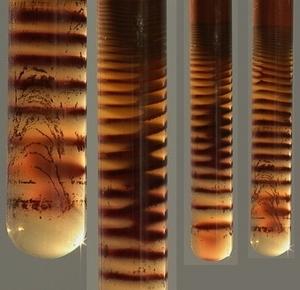
|
| Description: |
Aquamarine with spiral inclusions 8 cm.
Sigartal, Baltistan, Pakistan
François Lietard (France) Specimen
Joaquim Callén Photo
Source: http://www.foro-minerales.com/forum/viewtopic.php?p=49923#49923 |
|
| Viewed: |
105497 Time(s) |
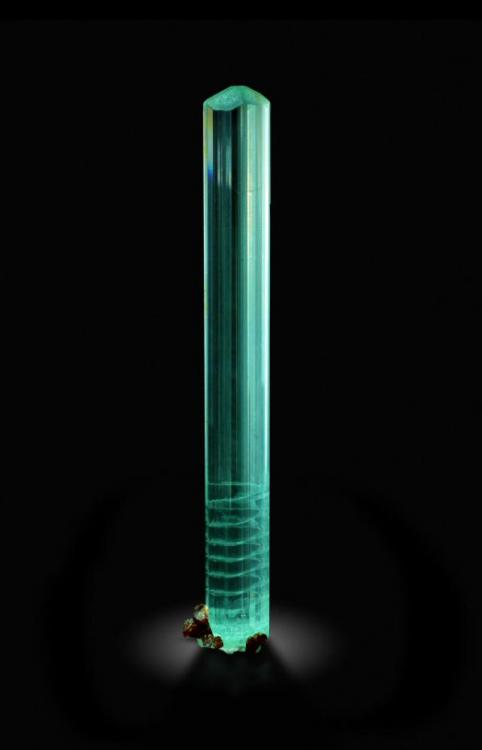
|
|
|
| Back to top |
|
 |
michael-thorn
Joined: 18 Apr 2011
Posts: 8
Location: Santa Rosa, California


|
 Posted: May 23, 2011 10:51 Post subject: Re: Inclusions of spiral or helical growth and screw dislocations - (0) Posted: May 23, 2011 10:51 Post subject: Re: Inclusions of spiral or helical growth and screw dislocations - (0) |
|
|
There is in quartz especially, a spiraling energy effect down the prime axis, similar to DNA. If one allows non-proven non-scientific ideas, there is a significant amount of data about rotating stars-of-david and geometric rotation effects in quartz crystals. There is also studies about magnetically induced rotation effects. i have no real comment, other than to inquire if the crystals are right or left handed, and if the rotation follows that...
_________________
I'm interested in laboratoryidentification, optical /chemical tests. |
|
| Back to top |
|
 |
Duncan Miller

Joined: 25 Apr 2009
Posts: 138
Location: South Africa



|
 Posted: May 28, 2011 01:25 Post subject: Re: Inclusions of spiral or helical growth and screw dislocations - (0) Posted: May 28, 2011 01:25 Post subject: Re: Inclusions of spiral or helical growth and screw dislocations - (0) |
|
|
At an atomic level quartz does have a helical structure (see Amir Akvan's website The Quartz Page for an excellent explanation of the structure of quartz) but so far I have not seen any images of these helical inclusions in quartz.
Duncan
|
|
| Back to top |
|
 |
michael-thorn
Joined: 18 Apr 2011
Posts: 8
Location: Santa Rosa, California


|
 Posted: May 28, 2011 10:58 Post subject: Re: Inclusions of spiral or helical growth and screw dislocations - (0) Posted: May 28, 2011 10:58 Post subject: Re: Inclusions of spiral or helical growth and screw dislocations - (0) |
|
|
I read that quartz has both left and right hand atomic intra=matrix tendencies, with one winning out, but having both always present, as in some twinning laws, or something...???
_________________
I'm interested in laboratoryidentification, optical /chemical tests. |
|
| Back to top |
|
 |
Elise

Joined: 22 Dec 2009
Posts: 243
Location: New York State



|
 Posted: Dec 11, 2011 10:38 Post subject: Re: Inclusions of spiral or helical growth and screw dislocations - (0) Posted: Dec 11, 2011 10:38 Post subject: Re: Inclusions of spiral or helical growth and screw dislocations - (0) |
|
|
While looking up something else, I found another report of this helical growth in spodumene, including nice images of the crystal and the formation: Gem News International, "Spodumene from Afghanistan with unusual inclusions", John I. Koivula, G&G, Fall 2008, Vol. 44, No. 3, pp. 278-219. The PDF is available for free online:
https://gia.metapress.com/content/3qu13j8258325651/fulltext.pdf
(link normalized by FMF)
_________________
Elise Skalwold |
|
| Back to top |
|
 |
|





